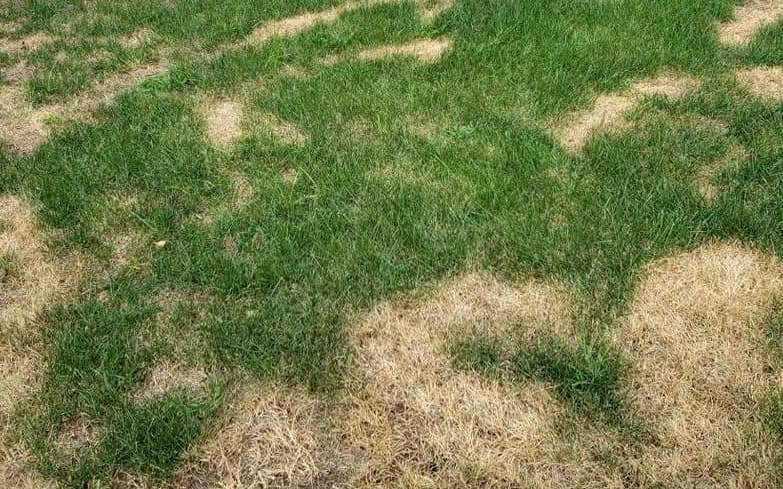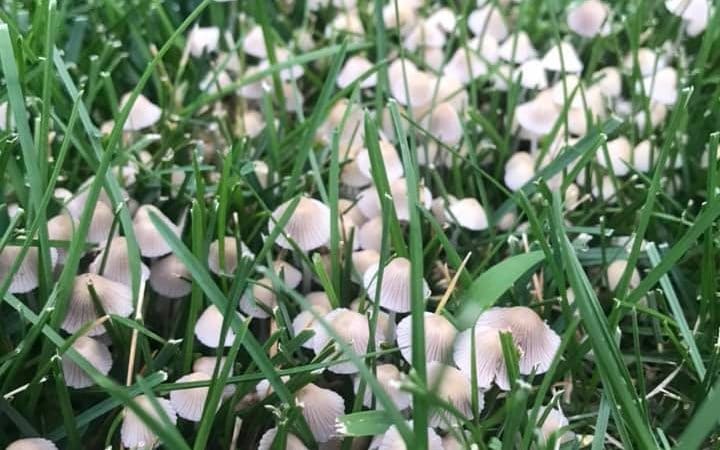So, the rule of thumb when it comes to watering your lawn is to use sufficient water but not too much.
However, that is confusing because how much water is too much, and what are signs of an overwatered lawn?
Signs of an overwatered lawn are growing fungi, water runoff, yellowing grass, a spongey yard, the presence of thatch, bug infestation, and the growth of weeds.
You can fix an overwatered lawn by watering less, dethatching, treating fungi issue, fertilizing, and getting rid of bugs and weeds.
A happy lawn is one that receives the right amounts of moisture and sunlight, so you should always strive to keep things balanced.
While the effects of underwatering are commonly known, overwatering is also problematic and should be addressed appropriately.
7 Signs Of Overwatered Lawn
Knowing the signs of overwatered grass is pretty beneficial to keeping a healthy yard.
Here are 7 signs you are overwatering your lawn:
1. Growing Fungi
Overwatering provides an excellent state for fungal growth, which you can detect through grass blades turning brown or yellow.
In addition, another distinct indicator is the growth of mushrooms across your yard.
Also read: Orange mushrooms in yard
Keep in mind that mushrooms can be harmful to children and pets, so you should strive to prevent their growth.
Also read: How to get rid of mushrooms in your yard
2. Spongy Lawn
Step on different parts of your lawn to feel how the grass feels, and if it’s squishy or spongy, it may indicate an overwatered lawn.
If that’s the case, you will need to minimize the water going into your yard.
3. Discoloration
Overwatering your lawn deprives the grass of essential nutrients needed for proper growth, and that is manifested in how the color of the grass changes to light green, yellow, or brown.
Too much moisture in your grass makes the roots rot gradually.
Read more: Why Is New Grass Turning Purple?
Rotten roots may also feel slimy or brown, and the ground spongy.
4. Thatch
Thatch refers to a layer of partly decomposed plant materials and roots that can be broken down by soil organisms giving the soil natural nutrients.
However, overwatering the lawn prevent these organisms from breaking down thatch, resulting in their build-up, and so you will see thatch everywhere in your lawn.
Excess thatch inhibits grass from getting oxygen and growing deep roots, thus harming your lawn’s quality.
5. Runoff
Water is undoubtedly not seeping into the ground if you see water streams running off down the street or sidewalk from your lawn.
This shows your yard is saturated and likely overwatered.
Besides wasting water, a runoff also washes away the nutrients necessary for the growth of your grass, compromising your lawn’s health.
Also read:How Often To Water New Sod?
6. Weeds
While lawns don’t like too much water, the opposite is true for weeds such as yellow nutsedge and smooth crabgrass.
Overwatering your yard provides the optimum condition for weeds to thrive, so a plethora of weeds in your lawn could signify overwatering.
7. Bugs Infestation
Besides depriving your lawn of oxygen and inhibiting a deep root system from developing, a thick thatch layer also provides an excellent hiding place for bugs.
It provides protection against predators, sunlight, and even pesticides.
You may be overwatering your lawn if bugs are becoming a serious menace, and you will need to deal with them before they cause devastating effects.
It is worth noting that lawns can be overwatered because of different circumstances, not just a homeowner enthusiastic to water their yards.
This can include leaving the sprinkler hoses running too long, showers, and humidity.
Pictures of Overwatered Grass


What Happens When You Overwater Your Lawn?
Overwatering your lawn can be detrimental to the grass as it stunts its growth and suffocates them.
Here are some effects of overwatering your lawn:
a) Grass suffocation
The soil beneath the turf comprises soil particles encircled by water and air pockets that provide your lawn’s roots with the water and oxygen necessary for them to grow and thrive.
However, overwatering the yard fills the air pockets with water depriving the soil of oxygen, thus suffocating your grass.
Related: How long should i keep my dog off new sod
b) Stunted growth of the lawn
Having water readily available in the soil means the roots don’t have to struggle to find moisture. Therefore, the grass root system doesn’t have to extend down or spread, translating in a yard with a shallow root system that’s vulnerable to disease and drought.
How To Fix An Overwatered Lawn
Fixing an overwatered lawn could include reducing the amount of water that goes into your lawn or aerating. Here some more ways to fix an overwatered lawn:
1. Reduce The Water
While it’s important to reduce the amount of water going into your lawn, don’t stop watering it altogether.
Determine the suitable quantity needed by the grass to thrive, taking into account the weekly/daily rainfall, the season, and the climate.
You are better off watering thoroughly but less frequently than a little bit daily.
Read more: How long to water grass
2. Aerate your lawn
Aerating your lawn and getting rid of the grass clippings is one of the best ways to fix overwatered lawn.
It also reduces the risk of compaction, improves nutrient uptake, and adds organic matter to the soil.
3. Dethatch
Considering the problems caused by the thatch in your lawn, it’s vital to get rid of the excess, meaning anything over ½ inch.
You can do so by raking out the thatch, but remember, this approach can be labor-intensive.
Alternatively, you can invest in dethatching products like Liquid Lawn Dethatcher applied on the thatch to aid the organisms in breaking down and decomposing thatch.
4. Eradicate Bugs
Dealing with thatch exposes the bugs giving you the perfect situation to deal with them. However, before killing them, find out what kinds of bugs they are to choose the correct pesticide.
5. Fertilize Your Lawn
Overwatering washes away nutrients in the soil, taking away what your lawn needs to grow. Therefore you must replenish your yard with nutrients by applying fertilizer.
An excellent all-around fertilizer will help turn your lawn green again. However, you can also test the soil to figure out what nutrients are missing and go for a specific fertilizer offering what you need.
Useful Tips For Watering Your Lawn
To ensure you don’t underwater or overwater your lawn, here are helpful tips to guide you while watering your grass.
- Early in the morning at around 10 am or earlier is the best time to water your lawn. This is because the temperatures are cooler; hence there’s less evaporation, and the water will help cool the yard during the hottest hours.
- The second watering session of the day should be late in the afternoon. You may create overwatering problems if you let your lawn soaked overnight, so don’t water too late.
- The grass blades are dehydrated when they curl, which means they need to be watered.
- If you see your fingerprints in the grass immediately after walking on your lawn, it needs water. Dehydrated grass cannot spring back up appropriately.
Final Thoughts
To summarize, you need to understand signs of an overwatered lawn, which are;
Signs of an overwatered lawn:
- Growing Fungi
- Weeds
- Spongy lawn
- Discoloration
- Thatch
- Runoff
- Bugs Infestation
Here’s how to fix over watered grass:
- Dial back watering: while it’s important to reduce the amount of water going into your lawn, don’t stop watering it altogether.
- Aerating and dethatching your lawn.
- Treat fungi issue.
- Eradicate Bugs.
- Fertilize your lawn.
Now adopt the correct steps to remedy the issue depending on the cause to help restore your lawn to its green, lush glory.
Reference
- University of Delaware – LAWN MANAGEMENT FOR WATER CONSERVATION
- University of Nebraska-Lincoln – Avoid Overwatering Lawns & Landscapes
- Purdue University Extension –Irrigation Practices for Homelawns

Hey there, I’m Derek Schew, a writer for Lawnholic.com, where we cover everything and anything related to lawns. As someone who’s spent countless hours tending to my own lawn, I’m passionate about sharing my knowledge and helping others achieve the perfect yard. From lawn care tips to product reviews, I’m committed to providing our readers with the most accurate and up-to-date information available. So whether you’re a seasoned lawn enthusiast or just getting started, I invite you to join our community and discover the joys of a lush, green lawn.
